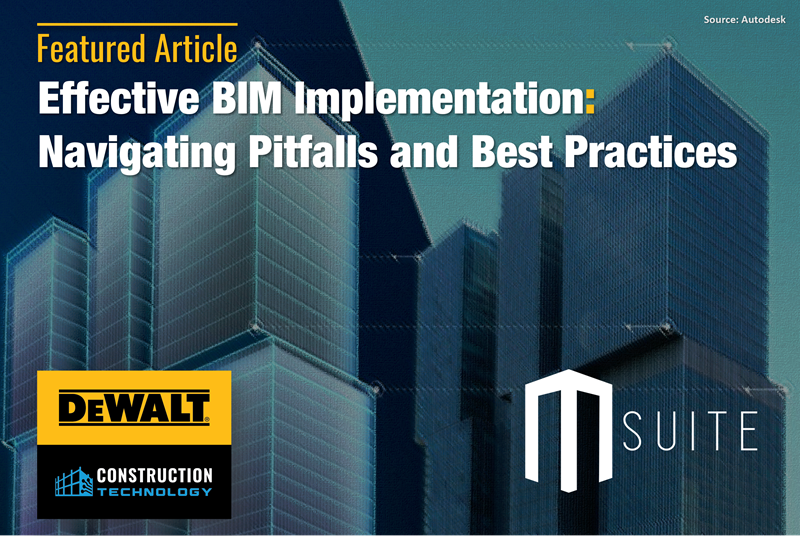BIM (Building Information Modeling) has become an indispensable tool for designers, architects, and project managers in the construction industry. While the benefits of BIM are substantial, it’s crucial to navigate through potential pitfalls during its implementation.
This article surfaces common mistakes to avoid and some best practices for integrating BIM into your operation.
Common Pitfalls in BIM Implementation:
- Lack of a Comprehensive BIM Execution Plan (BxP):
- One common mistake is underestimating the importance of a BIM Execution Plan. Contrary to the belief that it’s only necessary for large projects, a simplified plan is better than none. Clearly defining project goals, objectives, and client expectations is essential. Incorporating BIM usage standards, such as 3D and 2D component agreements, enhances workflow productivity. Regular updates to the plan ensure alignment with project modifications.
Benefits of a BIM Implementation Plan:
- Collaboration: Facilitates real-time collaboration, reducing issues and silos among project tasks.
- Time-savings: Focuses on crucial project benefits, minimizing delays and ensuring timely deliverables.
- Communication: Encourages immediate communication between teams and stakeholders, managing expectations effectively.
- Execution: Streamlines communication and collaboration, eliminating confusion and ensuring projects stay on course.
- Data sharing: Promotes transparency by making BIM data accessible to all project stakeholders.
High Implementation Cost:
- The high cost associated with BIM adoption extends beyond machinery and technology expenses. Streamlining corporate processes, considering staff training costs, and aligning equipment with BIM can be challenging for smaller businesses. Collaboration with external consultants can help integrate BIM technologies effectively.
Starting the BIM Process Too Early:
- While introducing BIM early can expedite construction timelines, initiating it too soon, especially during an iterative design process, can lead to additional coordination work. Timing BIM commencement when coordination can be completed two weeks before construction minimizes costs and enhances efficiency.
Using Inappropriate Hardware and Hosting Methods:
- Consulting a BIM manager or expert ensures the selection of suitable hardware for a specific BIM implementation. Cloud servers, providing open accessibility, are preferred over local file usage for storing BIM files.
Using BIM Systems with Non-BIM Systems:
- Maintaining a balance between BIM and non-BIM technology in the office is crucial. Carefully selecting BIM training projects based on team size and availability helps ensure billable time efficiency.
Avoiding Placeholder Usage:
- Success in BIM relies on substituting placeholders with genuine content. Prioritize accurate materials during the BIM process to demonstrate decision-making clarity and avoid uncertainty.
Incomplete or Inaccurate Building Information:
- Simplify BIM Implementation by creating straightforward 2D and 3D families with compatible file sizes. Avoid overcomplicating the modeling process with unnecessary details and maintain compatibility for adequate representation.
Inadequate Staff Preparation:
- Appointing a dedicated BIM Coordinator is crucial for conflict resolution. Overcoming obstacles such as fear of failure and lack of support requires strategic decisions and collaboration between management and employees.
Not Running Quality Checks:
- Regular assessments ensure that the BIM stays on track. Confirm that the model aligns with on-site construction methods and includes implementable material specifications. After completing the BIM modeling project, each system’s crucial step, known as quality assurance (QA), is undertaken.
The purpose of QA is error elimination, ensuring a flawless outcome. BIM QA/QC (Quality Assurance/Quality Control) involves scrutinizing the BIM model to ensure compliance with various BIM standards. This inspection of the 3D BIM model focuses on identifying clashes, improper naming, and any other inconsistencies. The BIM QA/QC process results in a meticulously examined, ready-to-use BIM model devoid of irregularities, presenting a coordinated integration of all systems.
Over-modeling:
- Avoid over-modeling by focusing on essential details that align with design requirements. Overly detailed models can lead to longer loading times and hinder sheet navigation speed.
Conclusion:
While incorporating BIM into construction projects is a positive step, avoiding common pitfalls is vital for success. A well-executed BIM implementation plan, cost-conscious decisions, strategic timing, and attention to detail contribute to a smoother workflow, making construction projects more efficient and timely.







